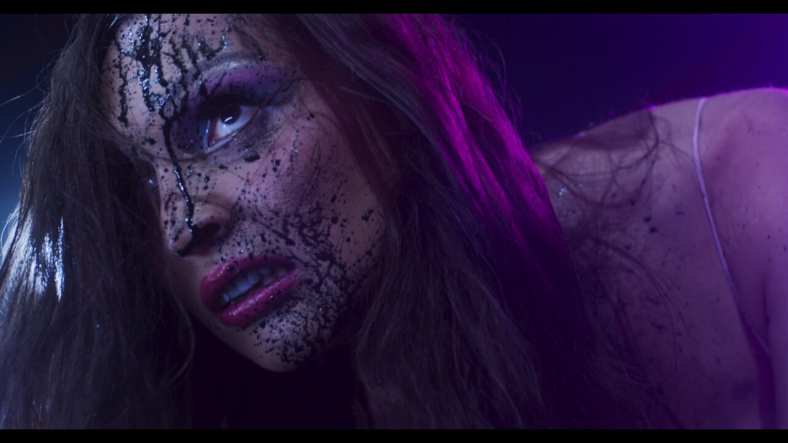‘Satranic Panic’ Review: Alice Maio Mackay’s Most Ambitious Film Yet

It’s not an exaggeration to say that Alice Maio Mackay’s directorial career is skyrocketing. In just three years she’s released three features, each deconstructing a portion of the queer or trans experience with equal parts heart and wit. So Vam tackles the monstrous “othering”, Bad Girl Boogey uses supernatural horror to examine how queer suffering is ignored en masse, and T-Blockers turns toxic sludge into a metaphor for transphobic vitriol. With a continued commitment to a largely LGBT cast and crew, Mackay continues creating high-quality films that perfectly encapsulate the young queer zeitgeist. Her latest feature Satranic Panic is no different. With her most ambitious story and style yet, Mackay tackles transphobic fear-mongering at her new creative peak.
In Satranic Panic, we meet Jay (Zarif), a struggling comic book artist, and Aria (Cassie Hamilton), a fairly successful songstress, at an emotional low point. Max (Sebastien Grech), Jay’s boyfriend and Aria’s brother, was brutally murdered by a cult not long ago. The two witnessed it firsthand, though the hate crime was naturally not taken seriously. Not long after, Aria’s regular estrogen shot left her with the ability to sense demons. With a possible clue to the demonic cult’s origins in Max’s belongings and Aria’s demon-sensing powers, the duo hit the road to avenge the third part of their found family. Funded by Aria’s impromptu tour and aided by mysterious ex-schoolmate Nell (Lisa Fanto), the friends travel through rural Australia killing demons and going on journeys of self-actualization.
Also Read: ‘The Last Stop In Yuma County’ Fantastic Fest 2023 Review: A Tense And Confident Crime Thriller
Each time Mackay releases a new feature, her confidence as a writer and director seems to increase exponentially. With her regular team of Ben Pahl-Robinson as co-writer (with Cassie Hamilton also joining them as co-writer) and Aaron Schuppen as cinematographer and editor, Satranic Panic is her most ambitious work on every level. The use of creative zooms and handheld shots in flashbacks gives a disorienting, almost Lynchian vibe. Fight scenes are punctuated with carefully chaotic cuts and provide a nice helping of great practical gore and decent digital effects. Nearly every scene is drenched in Mackay’s trademark shifting giallo lights, though there are several scenes lit beautifully during magic hour that give a soft, beautiful contrast.
The script balances the tone between Doom Generation-esque blunt, dark comedy and a Phantom of the Paradise style sci-fi demonic musical nightmare. Much like her previous works, the film feels consistently cool without feeling forced. It’s visually and audibly appealing to this generation of young queer adults. Mackay is creating works much like the heads of New Queer Cinema (think Gregg Araki, Lizzie Borden, Todd Haynes, and more)—who she often references both outright and through visual cues in her filmography.
Also Read: ‘The Sacrifice Game’ Fantastic Fest 2023 Review: Jenn Wexler’s Latest Is A Perfectly-Wrapped Holiday Horror Gift
It’s obvious that Mackay and crew are lampshading the “Satanic Panic”: right-wingers claiming anything impeding on “Christian values” is of the Devil. These groups have mobilized for decades to eradicate any counter-cultural from Iron Maiden to Sailor Moon. The panic obviously extends beyond pop culture and continues to target identities that do not conform to conservative Christianity. Again, like her other works, Mackay’s particular talent for satirizing and deconstructing how utterly nonsensical transphobic rhetoric is front and center.
The demons and their nefarious leader (Chris Asimos, who keeps killing it in these campy evil roles) aim to inspire dysphoria and force detransition upon all trans people everywhere. Though their alleged reasoning stems from warped pseudo-scientific reasoning, the actual reasoning stems from the same feelings the cult weaponizes against their victims: dysphoria and self-hatred. The villains grew up suppressing the same dysphoric feelings that their victims did, an obvious Rocky Horror Picture Show homage visually highlights this, but instead turned to “facts and logic” to systematically tear down those who chose to become the best version of themselves.
Within the larger narrative of a bigoted moral panic, Mackay tackles internal issues in the queer community as well. Like this year’s Saint Drogo, the larger LGBT community is also fair game for Mackay’s witty ire. As we’ve seen over the last couple of years, there are plenty of cisgender LGBT community members more than willing to sacrifice their trans brethren for acceptance.
Also Read: ‘Totally Killer’ Review: A Film With Franchise Potential
A leather daddy and drag queen demon serve as perfect examples. The disparity between Jay and Aria, friends at two very different points in transitioning, also creates some interesting analysis. It informs where they are in grieving Max’s death and how they’re able to interact with various strangers along their journey. A much more self-assured Aria willingly takes risks and places herself in danger compared to the much more obvious gender non-conforming Jay. She’s never unsympathetic, but her brash confidence sometimes borders into a shell of narcissism or selfishness. Both Aria and Jay are well-developed, three-dimensional characters portrayed beautifully by Hamilton and Zarif respectively. They, as well as Nell, all highlight inherent insecurities with choosing to be an out queer or trans person.
Satranic Panic is another stellar inclusion to both Alice Maio Mackay’s filmography and the wave of independent queer horror we’ve had for the last few years. Its smart and slick deconstruction of factually unsubstantiated moral panic is backed up by a fun style, witty dialogue, and Mackay’s own understanding of what young queer adults are like. Her love for the creatives of queer cinema of past decades combines with her own distinct voice in a beautiful synthesis of gritty, heartfelt, and truly queer sensibilities. There’s always something beautiful in watching something made by and for trans people, and Mackay continues to make films that are unabashedly that.
Summary
Satranic Panic is Alice Maio Mackay’s most ambitious and stylish film yet, tackling transphobic fear-mongering at her new creative peak.
Categorized:Reviews

